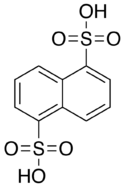Armstrong's acid
|
|
|||
| Names | |||
|---|---|---|---|
|
IUPAC name
Naphthalene-1,5-disulfonic acid
|
|||
| Other names
Armstrong's acid
|
|||
| Identifiers | |||
|
3D model (JSmol)
|
|||
| ChEBI | |||
| ChemSpider | |||
| ECHA InfoCard | 100.001.199 | ||
|
PubChem CID
|
|||
|
|||
|
|||
| Properties | |||
| C10H8S2O6 | |||
| Molar mass | 288.299 g/mol | ||
| Appearance | colorless solid | ||
| Hazards | |||
| Main hazards | corrosive | ||
|
Except where otherwise noted, data are given for materials in their standard state (at 25 °C [77 °F], 100 kPa).
|
|||
|
|
|||
| Infobox references | |||
Armstrong's acid (naphthalene-1,5-disulfonic acid) is a fluorescent organic compound with the formula C10H6(SO3H)2. It is one of several isomers of naphthalenedisulfonic acid. It a colorless solid, typically obtained as the tetrahydrate. Like other sulfonic acids, it is a strong acid. It is named for British chemist Henry Edward Armstrong.
It is prepared by disulfonation of naphthalene with oleum:
Further sulfonation gives The 1,3,5-trisulfonic acid derivative.
Fusion of Armstrong's acid in NaOH gives the disodium salt of 1,5-dihydroxynaphthalene, which can be acidified to give the diol. The intermediate in this hydrolysis, 1-hydroxynaphthalene-5-sulfonic acid, is also useful. Nitration gives nitrodisulfonic acids, which are precursors to amino derivatives.
The disodium salt is sometimes used as a divalent counterion for forming salts of basic drug compounds, as an alternative to the related mesylate or tosylate salts. When used in this way such a salt is called a naphthalenedisulfonate salt, as seen with the most common salt form of the stimulant drug CFT. The disodium salt is also used as an electrolyte in certain kinds of chromatography.
...
Wikipedia


